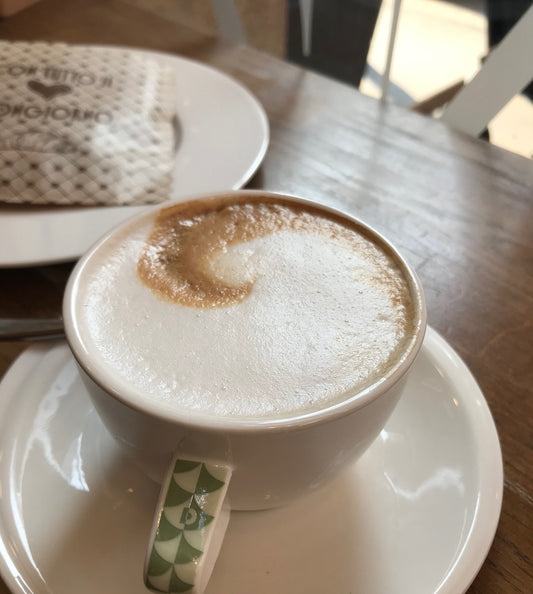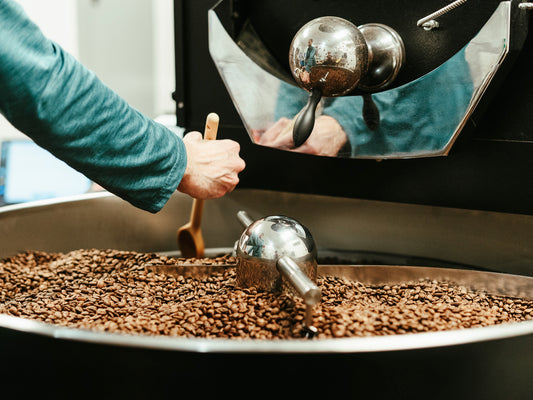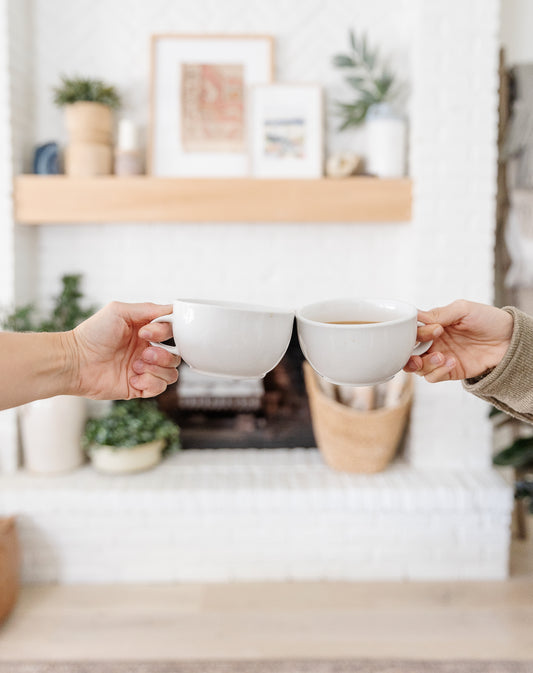A Roaster’s Perspective on the Differences between Roast Levels

Ah, the aroma of freshly roasted coffee beans! For coffee lovers, there's nothing quite like it. At Window Seat Coffee, we take pride in our commitment to delivering the finest quality coffee right to your doorstep. But have you ever wondered about the differences between light, medium, and dark roasts? Or have you noticed that many craft coffee roasters (including us!) refer to profile roasting? What does that even mean? Oh and what are cold brew blends or espresso blends? Do roasters do anything differently to create these roasts? In this blog post, we’ll take you through all of these and more!
Coffee 101: An Introduction
Before we get into roasting, let’s fly through some coffee basics. All of your favorite roasted coffee starts life as seeds from the fruit of the Coffea tree. While there are many species of Coffea (over 100!), the two most common are Coffea Arabica and Coffea Robusta. In general, Arabica coffee is known for being higher quality and better tasting, while Robusta is known for being lower in quality (though Robusta and Robusta hybrids are gaining in popularity). We do not currently have any Robusta offerings, though aren’t opposed to offering them in the future if we feel confident in the end product.

In the life cycle of roasted coffee, roasters receive green beans, which are then roasted to create the product you know and love. However, before the green beans even get to the roaster, the coffee seeds need to be processed, which happens in the country of origin. Processing involves separating the seeds from the flesh of the fruit, cleaning/washing the seeds, and preparing the green coffee to be shipped. For a deeper dive into this, be sure to check out our blog post "What is Craft Coffee?"
Coffee Processing
The three most common processing methods are known as washed, semi-washed (also includes honeyed and pulped natural), and natural. With all of the experience we have gained, we can confidently say that one process doesn’t inherently produce better coffee than another. Each process can produce great tasting coffee so be sure to give them all a try! Below are few pictures of green coffee we recently purchased and roasted.
First is our current Weekender offering. It is a naturally-processed Ethiopia from the Derkidame community in the Guji Zone. The green coffee is above our roasted coffee in the photo. Note the multi-colored appearance of both the green and roasted beans.

Next is our current Red Eye offering. It is a pulped natural (semi-washed) Brazil from the Fazenda Rainha coffee estate located near the municipality of São Sebastião da Grama, within the state of São Paulo.

Below is a current single-origin we are offering. It is a washed Colombia from four producers in the farms in the municipality of Palestina, within the department of Huila.

The final process we want to highlight is our current Staycation decaf offering. It is a water-processed Peru from multiple producers in the country. Note the dark appearance of these green coffee beans.

Coffee Roasting
Now that you’ve seen the beginning and end products, how does someone roast coffee anyway? Like many things in life, the answer can be very simple or very complex, though the basics are pretty straightforward: you add a lot of heat to green coffee for a short period of time until you are satisfied it is fully roasted.
In fact, you could buy green beans online, put them in a pan and heat them on your stove to accomplish your goal of becoming a home roaster. Congrats! Now, should you do this? ABSOLUTELY NOT! We definitely would not recommend this approach. Nothing says I’m a true craft coffee roaster like fire and smoke in your kitchen, right?

On the more complex side, coffee roasting involves large precision built machines and specialized roasting software. We love our Probat P12 roaster and think it produces some seriously great roasts. We also utilize a great (and free!) roasting software called Artisan.
Roast Levels
All right, so what is the difference between a light, medium, and dark roast? Well, it depends. While coffee roasting is a pretty specialized field with many sophisticated businesses doing it, there isn’t a governing body that decides on and imposes roast level definitions. Therefore, what is marketed by one roaster as a medium roast could be called a light (or a dark) roast by another. That being said, there are generally accepted terms and best practices.
When it comes to roast level, we like what is described in Scott Rao’s book, The Coffee Roaster’s Companion. Rao breaks down the categories of roast level (from light to dark) as follows: Cinnamon, City, Full City, Viennese, French, and Italian.
We won’t get into too many details on this scale, but we do aim for City+, Full City, or Full City+ on our roasts. We also want to note that you won’t ever receive a roast from Window Seat Coffee that is oily (generally Viennese and darker) as we don’t believe these types of roasts do justice to the quality of specialty coffee. It is our opinion that darker, oily roasts mask the natural flavor of coffee, so we don’t offer coffee roasted to that level. However, if you like dark profiles, we really think you should try our Red Eye blend! We make sure this blend always ends up with notes of dark chocolate and roasted nut, so we believe it matches a dark roast lovers tastes very well.
Ok, so you’ve reviewed the above pictures and have a question: is roast level really determined by looking at the beans and then basing it off the color? Honestly, yes, that’s pretty much it; it is usually a process based on visual inspection. There are some complicated methods for scientifically measuring the roast color of your coffee, but most roasters don’t actually do this (I’ll admit we don’t, ha!)
The reason we don’t use the above method is pretty simple: we don’t believe they are very consistent or helpful. First of all, green coffee doesn’t start out as the same color. All decaf green coffee is darker and many African coffees are slightly lighter than green coffee from other parts of the world. Additionally, looking at our Ethiopia green coffee above, you can see it is a speckled mix and this speckled look will hold true after roasting. Therefore, it’s pretty difficult to gauge any bean’s roast level by visually comparing it to a color scale. While we haven’t purchased some of the other expensive color spectrometers, we’ve reliably heard from others they aren’t very consistent. I think that’s why most roasters go with a visual inspection and their opinion. But there is also another consideration: how does profile roasting relate to the ending roast color?

Let’s try to clear it up when it comes to Window Seat Coffee. We perform what we consider profile based roasting for every green bean. This means we utilize Artisan to track a few metrics (e.g., bean temperature, drop temperature, drop time, DTR%) and based on these variables and the resulting taste, we create a different roast plan for every bean. Our goal is to make each bean taste its best, highlighting sweetness and minimizing roasting defects. We use our experience and industry best practices to end up with a roast that tastes great while letting the natural flavor of the bean shine. It takes some time (and lots of trial and error) to get this method to work well, but we think it’s worth it!
To circle back to roast level, for us the end color is more a byproduct than a desired goal. We aren’t necessarily concerned whether a roast is technically a City+ or a Full City, or an Agtron 60. We think that kind of misses the point. The point is to create a roast profile for the bean that tastes great. This means when we market our roast levels, rather than using a scientific color that is hard to capture, we try to communicate how our customers (and us) describe the taste. So we feel comfortable saying our Weekender Blend is a light roast since that’s how many of customers describe it.
While we have only touched on the details of profile roasting here, we’ll have a post more in depth on profile roasting coming soon. Be sure to sign up for our mailing list to stay up to date!
Common Roasting Questions and Misconceptions
Ok, that was a lot of information! Let’s move on to a few common questions we get about roasting, including some potential misconceptions.
First up, do dark or light roasts have more caffeine? The basic answer is darker roasts have more caffeine due to the fact that roasting does not change the caffeine content, but it does reduce the mass of the green beans.

More specifically, coffee beans are chemically comprised of water (our beans are usually ~10-15% water), so the high temperature during the roasting process will reduce the moisture content, and as a result, shrink the overall mass of the bean.
This means when you use 27 grams of a darker roast for your pour-over, it has more beans (and more caffeine) than an equivalent 27 gram lighter roast. We should add an important caveat to this discussion: the caffeine content of coffee is still debated. Over the years, we have heard many varying facts about the consistency and amount of caffeine in coffee from other coffee professionals. A quick online search will let you know there are a lot of “answers” to how much caffeine is in a cup of coffee. Our takeaway for the curious would be this: know that all coffee (including decaf) has caffeine in it, and listen to your body about how it affects you.
Roasts and Blends
Next up, what do roasters do differently to create an espresso roast or a cold brew roast? The simple answer is nothing. This is because the terms “espresso” and “cold brew” are brewing methods not roasting methods. However, we would like to assure you that your favorite roaster knows this fact and they aren’t trying to trick you! When a roaster tells you that their roast is, for example, a cold brew roast or cold brew blend, what they are telling you is that they believe that bean with their roast style makes a great cold brew (for example, our Ski Trip blend, which we believe makes an incredible cold brew). You can truly use any brew method with any bean, though, so experiment a little to find out what you like most.

Now a question we get in many forms: what’s the deal with decaf coffee and is it roasted differently? The details surrounding decaf coffee could be it’s own post, but we’ll do our best to hit the highlights here. First, we use the same profile roasting techniques on our decaf coffee as our other beans. We also offer decaf ready-to-drink cold brew because, again, we believe decaf can be great! However, we certainly know that decaf coffees tend to get a bad reputation. The reality is that the decaffeination process (which occurs in the country of origin) does impart a unique flavor on the coffee, which some people describe as malt, raisin, spice, or even barbecue. We suggest trying a decaf before you judge it!
Another important decaf fact: all decaf coffee starts life as caffeinated coffee. While there are many processes employed to remove the caffeine, at Window Seat Coffee, we only purchase water-processed decaf coffee. It’s important to note there are multiple versions of water processing, but the most known example is the Swiss Water Process. While our coffee is not always treated with the Swiss Water Process, the details of all water processes are similar. For even more decaf discussion, we highly recommend this blog post from Royal Coffee.
Conclusion: Embrace the Diversity of Coffee Roasts
In the world of coffee, the choice between light, medium, dark, or profile roasts is like choosing where to to go for a quick weekend escape – there really isn’t a right or wrong answer. We recommend you gain as much experience as you can and pick the coffees (and trips) you like best.
That being said, at Window Seat Coffee, we believe in letting specialty coffee speak for itself. That’s why we embrace profile roasting; specifically, we aim to emphasize the natural sweetness and flavors inherent in each bean.
Next time you're brewing a cup, take a moment to appreciate the craftsmanship that goes into each roast and the extraordinary range of flavors that coffee has to offer. Go ahead, explore, experiment, and find your perfect roast. Your coffee adventure awaits!
Some items linked here use affiliate links. When you click on an affiliate link and make a purchase Window Seat may receive a commission. Thank you!




